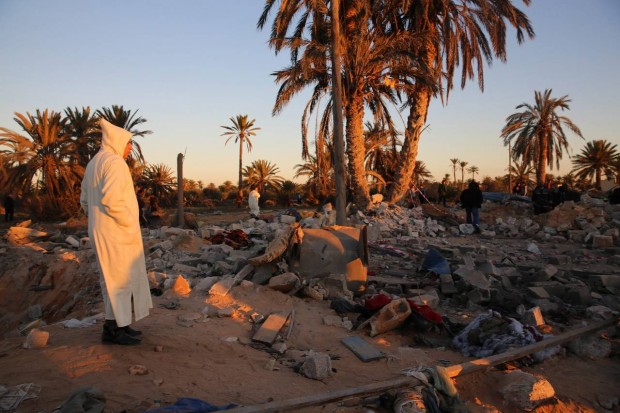Italy gives Sicily airbase for U.S. airstrikes against IS in Libya

The Italian government last month quietly began allowing armed American drones to fly out of an air base in Italy for military operations against Islamic State in Libya and across North Africa—a breakthrough for Washington after more than a year of negotiations, U.S. officials said.
But Rome’s green light came with the kind of caveat that has crimped U.S. attempts to win allies’ help in fighting the extremist group: The Italians granted permission for the drones to be used only defensively, to protect U.S. special-operations forces in Libya and beyond, the officials said.
U.S. officials are still attempting to persuade the Italian government to allow the drones, based at Naval Air Station Sigonella on the island of Sicily, to be used for offensive operations like one the U.S. conducted Friday against a training camp near Sabratha, Libya, targeting a senior Islamic State operative from Tunisia.
But in private conversations over the past year, Italian officials have balked at that step, the American officials said, fearful of igniting domestic antiwar opposition, especially in cases in which the Italians could be blamed for civilian casualties. In addition, the Italians say they want any drone strikes to target only non-Libyans to avoid inflaming political tensions there, the officials said.
Italian Prime Minister Matteo Renzi’s office declined to comment.
Fears about such operations are real: The Serbian government said on Saturday that Friday’s strike—conducted by manned American aircraft based in the U. K.—had killed two Serbian hostages who were being held at the camp. U.S. officials haven’t confirmed any civilian casualties among the dozens killed.
U.S. drones have been based in Sigonella since 2011 but until last month they were used for surveillance purposes only.
The new permission to allow armed drones, which hasn’t been disclosed previously, comes as the Obama administration is considering a more comprehensive strategy against Islamic State in Libya.
That could lead to a campaign in which a small, multinational coalition conducts sustained airstrikes and specialized forces work with Libyan forces to fight the extremists, U.S. officials said.
But the White House isn’t eager to commit to such a strategy. The “parent tumor” of Islamic State, as Defense Secretary Ash Carter often says, remains in Iraq and Syria.
“We’re going to continue to respond to the ISIL threat as it develops,” Pentagon spokesman Peter Cook said Friday, using an acronym for Islamic State in describing the current U.S. strategy. “We are carrying out a significant campaign against ISIL in Iraq and Syria, and we are prepared—as we have demonstrated in the last 24 hours—to strike ISIL in other parts of the world, as they pose a threat.”
Sigonella is a North Atlantic Treaty Organization and Italian air base as well as a U.S. Navy installation, not far from Mount Etna. It has often been used as a launchpad for military activities in the Mediterranean, including NATO airstrikes during the Libyan war.
The U.S. mainly uses it for drone operations, but it isn’t an ideal solution, since weather conditions such as cloud cover often mean drone flights from Sigonella to Libya have to be scrapped.
The U.S. also is seeking to establish a drone base in North Africa to put aircraft even closer, increasing the efficiency and speed of such operations, according to officials familiar with such operations. But talks with North African countries haven’t yet borne fruit, U.S. officials said.
All this takes place as the U.S. and its allies await the outcome of talks in Libya on forming a unity government—a necessary step for creating a viable partner with which to fight Islamic State.
The Italian government has said if a unity government were formed it would send a stabilization force to Libya of 5,000 or more troops. Both the French and the British have suggested they are willing to provide support to the Italian lead mission. The U.S. is expected to provide air assets, including surveillance and transport aircraft, for such a mission.
Still, a unity government in Libya has remained elusive.
Meanwhile, Washington has been lining up ways to counter Islamic State’s rapidly growing influence in Libya, where it now has an estimated 6,000 fighters, according to the Pentagon.
The permission the U.S. had sought from the Italians was a long time in coming. Secretive talks began early last year and didn’t take any real form until April, said an official knowledgeable about the talks.
But as American troops played a bigger role, the need for means to protect them became more evident.
Last year, the Pentagon began sending special-operations forces into Libya to assess individual groups with whom the U.S. could work if a unity government were formed.
Those teams, typically in civilian clothes, began holding “key leader engagements” with Libyan military members and other individuals and groups in Libya in which, as one defense official said, they often “shook hands and exchanged business cards.” As perilous as the meetings could be, in time the teams were lulled into thinking they could slip in and out of the country unnoticed by militants, according to two U.S. officials familiar with those operations.
Then, in December, a team was “outed” by members of the Libyan military after confusion among Libyan groups as to who had allowed the Americans to enter the country, according to a senior military official. That led to members of the Libyan air force posting a picture of the Americans on social media, thus exposing their presence.
They were quickly ferried out of the country on an AC-146 cargo plane that wasn’t large enough to carry all their gear. In a sign of how quickly they were extracted, the group was forced to leave their All-Terrain Vehicles, or ATVs, and other equipment behind. They were flown first to Sigonella, then to their home base at Baumholder, Germany, defense officials said.
The episode demonstrated the extent of risk facing American forces. Days later, around Christmas, Mr. Carter and his Italian counterpart, Roberta Pinotti, spoke by phone. She told him the Italian government would agree to allowing armed drones at Sigonella, but only for defensive measures, the officials said. And, as is standard practice, it retained the right to approve or veto each mission.
In Friday’s U.S. strike, Rome only gave permission for U.S. aircraft at Sigonella to conduct rescue operations in the event that one of the U.S. jets went down or if there was another emergency, U.S. officials said.
Left-leaning members of Mr. Renzi’s own party oppose any military intervention in Libya, even against Islamic State—a stance many Italian voters support, according to opinion polls.
“It’s fair to say that the Italians had to go through a complex approval process on their side in order to grant us approval to fly these missions,” a senior defense official said.
How to submit an Op-Ed: Libyan Express accepts opinion articles on a wide range of topics. Submissions may be sent to oped@libyanexpress.com. Please include ‘Op-Ed’ in the subject line.
- Libya Reports Rising Oil Output - January 15, 2025
- Aguila, Turkish Envoy Discuss Cooperation - January 14, 2025
- Sahara Bank Officials Jailed in 53m Dinar Credit Fraud - January 14, 2025


